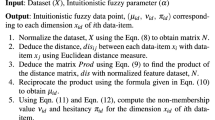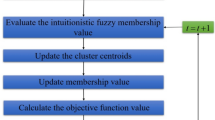Abstract
Atanassov intuitionistic fuzzy set (AIFS)-based C-means algorithms are successful in clustering uncertain or vague real-world datasets. The AIFS-based clustering algorithms are classified into adaptive class and non-adaptive class. An algorithm from the adaptive class computes its feature weight distribution with the help of the given dataset. On the other side, the algorithm belonging to the non-adaptive class mostly computes the feature weight distribution by employing an equally likely approach. The guarantee to reach up to the mark clustering performance is missing within this approach. Simultaneously, the performance gets deteriorated if the datasets showcase noises/irrelevant features. The irrelevant features in the datasets add to the computational cost. So, a feature reduction-equipped clustering algorithm called uni-weighted intuitionistic fuzzy C-means (uW-IFCM) is introduced in the paper. Moreover, the probabilistic weights-based adaptive clustering algorithm, namely bi-weighted probabilistic intuitionistic fuzzy C-means (bW-PIFCM) is proposed under the AIFS environment. The parametric analysis for uW-IFCM is provided to comprehend and compare its performance with bW-PIFCM, PIFCM, IFCM, and FCM algorithms. Here, an intuitionistic data fuzzification technique transforms the real-valued dataset into AIFS dataset, therefore bW-PIFCM and uW-IFCM algorithms cluster the real-valued datasets. The research proposal of Yang and Nataliani in [IEEE Transactions on Fuzzy Systems, 26(2), 817–835] motivates us to introduce a feature reduction-equipped uW-IFCM algorithm. We have considered synthetic datasets and some UCI machine learning datasets for the experimental study of uW-IFCM and bW-PIFCM. The efficacy and the precision of proposed algorithms are tested in terms of some popular benchmark indexes as well.















Similar content being viewed by others
References
Agrawal, R., Gehrke, J., Gunopulos, D., Raghavan, P.: Automatic subspace clustering of high dimensional data for data mining applications. In: Proceedings of the 1998 ACM SIGMOD International Conference on Management of Data, pp. 94–105 (1998)
Vidal, R.: Subspace clustering. IEEE Signal Process. Mag. 28(2), 52–68 (2011)
Sander, J., Ester, M., Kriegel, H.-P., Xiaowei, X.: Density-based clustering in spatial databases: the algorithm gdbscan and its applications. Data Min. Knowl. Discov. 2(2), 169–194 (1998)
Valente, D.O.J., Witold, P.: Advances in Fuzzy Clustering and Its Applications. Wiley, New York (2007)
Cohen-Addad, V., Kanade, V., Mallmann-Trenn, F., Mathieu, C.: Hierarchical clustering: objective functions and algorithms. J. ACM 66(4), 1–42 (2019)
Bezdek, J.C., Ehrlich, R., Full, W.: Fcm: the fuzzy c-means clustering algorithm. Comput. Geosci. 10(2–3), 191–203 (1984)
Zeshui, X., Junjie, W.: Intuitionistic fuzzy c-means clustering algorithms. J. Syst. Eng. Electron. 21(4), 580–590 (2010)
Qiu, C., Xiao, J., Yu, L., Han, L., Iqbal, M.N.: A modified interval type-2 fuzzy c-means algorithm with application in mr image segmentation. Pattern Recogn. Lett. 34(12), 1329–1338 (2013)
Chengmao, W., Xiaokang, G.: A novel interval-valued data driven type-2 possibilistic local information c-means clustering for land cover classification. Int. J. Approx. Reason. 148, 80–116 (2022)
Ji, Z., Sun, Q., Xia, Y., Chen, Q., Xia, D., Feng, D.: Generalized rough fuzzy c-means algorithm for brain mr image segmentation. Comput. Methods Programs Biomed. 108(2), 644–655 (2012)
Li, F., Ye, M., Chen, X.: An extension to rough c-means clustering based on decision-theoretic rough sets model. Int. J. Approx. Reason. 55(1), 116–129 (2014)
Chen, N., Ze-shui, X., Xia, M.: Hierarchical hesitant fuzzy k-means clustering algorithm. Appl. Math. A 29(1), 1–17 (2014)
Gustafson,D.E., Kessel, W.C.: Fuzzy clustering with a fuzzy covariance matrix. In: 1978 IEEE Conference on Decision and Control Including the 17th Symposium on Adaptive Processes, pp. 761–766. IEEE (1979)
Kuo-Lung, W., Yang, M.-S.: Alternative c-means clustering algorithms. Pattern Recognit. 35(10), 2267–2278 (2002)
Lee, J.Y., Kim, D., Mun, J.Y., Kang, S., Son, S.H., Shin, S.: Texture weighted fuzzy c-means algorithm for 3d brain mri segmentation. In: Proceedings of the 2018 Conference on Research in Adaptive and Convergent Systems, pp. 291–295 (2018)
Liu, X., Li, X., Zhang, Y., Yang, C., Xu, W., Li, M., Luo, H.: Remote sensing image classification based on dot density function weighted fcm clustering algorithm. In: 2007 IEEE International Geoscience and Remote Sensing Symposium, pp. 2010–2013. IEEE (2007)
Miin-Shen, Y., Sinaga Kristina, P.: Collaborative feature-weighted multi-view fuzzy c-means clustering. Pattern Recognit. 119, 108064 (2021)
Wenyuan, Z., Tianyu, H., Jun, C.: A robust bias-correction fuzzy weighted c-ordered-means clustering algorithm. Math. Probl. Eng. (2019). https://doi.org/10.1155/2019/5984649
Li, J., Gao, X., Ji, H.: A feature weighted FCM clustering algorithm based on evolutionary strategy. In: Proceedings of the 4th World Congress on Intelligent Control and Automation (Cat. No. 02EX527), Vol. 2, pp. 1549–1553. IEEE (2002)
Wang, X., Wang, Y., Wang, L.: Improving fuzzy c-means clustering based on feature-weight learning. Pattern Recognit. Lett. 25(10), 1123–1132 (2004)
Yang, M.-S., Nataliani, Y.: A feature-reduction fuzzy clustering algorithm based on feature-weighted entropy. IEEE Trans. Fuzzy Syst. 26(2), 817–835 (2017)
Stephan, T., Sharma, K., Shankar, A., Punitha, S., Varadarajan, V., Liu, P.: Fuzzy-logic-inspired zone-based clustering algorithm for wireless sensor networks. Int. J. Fuzzy Syst. 23, 506–517 (2021)
Wang, G., Wang, J.-S., Wang, H.-Y.: Fuzzy c-means clustering validity function based on multiple clustering performance evaluation components. Int. J. Fuzzy Syst. 24(4), 1859–1887 (2022)
Sinaga, K.P., Hussain, I., Yang, M.-S.: Entropy k-means clustering with feature reduction under unknown number of clusters. IEEE Access 9, 67736–67751 (2021)
D’Urso, P., Leski, J.M.: Fuzzy clustering of fuzzy data based on robust loss functions and ordered weighted averaging. Fuzzy Sets Syst. 389, 1–28 (2020)
He Yu-Lin, O., Gui-Liang, P.F.-V., Huang, J.Z., Suganthan, P.N.: A novel dependency-oriented mixed-attribute data classification method. Expert Syst. Appl. 199, 116782 (2022)
Sun, L., Zhang, J., Ding, W., Jiucheng, X.: Feature reduction for imbalanced data classification using similarity-based feature clustering with adaptive weighted k-nearest neighbors. Inf. Sci. 593, 591–613 (2022)
Nha, V.P., The, P.L., Pedrycz, W., Ngo, L.T.: Feature-reduction fuzzy co-clustering approach for hyper-spectral image analysis. Knowl. Based Syst. 216, 106549 (2021)
Siminski, K.: An outlier-robust neuro-fuzzy system for classification and regression. Int. J. Appl. Math. Comput. Sci. 31(2), 303–319 (2021)
Khan, M.A., Arshad, H., Nisar, W., Javed, M.Y., Sharif, M.: An integrated design of fuzzy c-means and nca-based multi-properties feature reduction for brain tumor recognition. In: Signal and Image Processing Techniques for the Development of Intelligent Healthcare Systems, pp. 1–28. Springer, New York (2021)
Atanassov, K.T.: Intuitionistic fuzzy sets. Fuzzy Sets Syst. 20(1), 87–96 (1986)
Chaira, T.: A novel intuitionistic fuzzy c means clustering algorithm and its application to medical images. Appl. Soft Comput. 11(2), 1711–1717 (2011)
Huang, C.-W., Lin, K.-P., Ming-Chang, W., Hung, K.-C., Liu, G.-S., Jen, C.-H.: Intuitionisti fuzzy c-means clustering algorithm with neighborhood attration in segmenting medial image. Soft Comput. 19(2), 459–470 (2015)
Iakovidis, D.K., Pelekis, N., Kotsifakos, E., Kopanakis, I.: Intuitionistic fuzzy clustering with applications in computer vision. In: International Conference on Advanced Concepts for Intelligent Vision Systems, pp. 764–774. Springer, New York (2008)
Lin, K.-P.: A novel evolutionary kernel intuitionistic fuzzy \(c\)-means clustering algorithm. IEEE Trans. Fuzzy Syst. 22(5), 1074–1087 (2013)
Hanuman, V., Agrawal, R.K., Aditi, S.: An improved intuitionistic fuzzy c-means clustering algorithm incorporating local information for brain image segmentation. Appl. Soft Comput. 46, 543–557 (2016)
Zhao, F., Chen, Y., Liu, H., Fan, J.: Alternate pso-based adaptive interval type-2 intuitionistic fuzzy c-means clustering algorithm for color image segmentation. IEEE Access 7, 64028–64039 (2019)
Zhou, X., Zhao, R., Fengquan, Yu., Tian, H.: Intuitionistic fuzzy entropy clustering algorithm for infrared image segmentation. J. Intell. Fuzzy Syst. 30(3), 1831–1840 (2016)
Namburu, A., Samayamantula, S.K., Edara, S.R.: Generalised rough intuitionistic fuzzy c-means for magnetic resonance brain image segmentation. IET Image Process. 11(9), 777–785 (2017)
Kaushal, M., Solanki, R., Danish Lohani, Q.M., Muhuri Pranab, K.: A novel intuitionistic fuzzy set generator with application to clustering. In: 2018 IEEE International Conference on Fuzzy Systems (FUZZ-IEEE), pp. 1–8. IEEE (2018)
Danish Lohani, Q.M., Solanki, R., Muhuri, P.K.: Novel adaptive clustering algorithms based on a probabilistic similarity measure over atanassov intuitionistic fuzzy set. IEEE Trans. Fuzzy Syst. 26(6), 3715–3729 (2018)
Szmidt, E., Kacprzyk, J.: Geometric similarity measures for the intuitionistic fuzzy sets. In: EUSFLAT Conference (2013)
Szmidt, E., Kacprzyk, J.: Distances between intuitionistic fuzzy sets. Fuzzy Sets Syst. 114(3), 505–518 (2000)
Zhexue, H.J., Ng Michael, K., Hongqiang, R., Zichen, L.: Automated variable weighting in k-means type clustering. IEEE Trans. Pattern Anal. Mach. Intell. 27(5), 657–668 (2005)
Danish Lohani, Q.M., Solanki, R., Muhuri, P.K.: A convergence theorem and an experimental study of intuitionistic fuzzy c-mean algorithm over machine learning dataset. Appl. Soft Comput. 71, 1176–1188 (2018)
Siminski, K.: Fuzzy weighted c-ordered means clustering algorithm. Fuzzy Sets Syst. 318, 1–33 (2017)
Asuncion, A., Newman, D.: Uci machine learning repository (2007)
Graves, D., Pedrycz, W.: Kernel-based fuzzy clustering and fuzzy clustering: a comparative experimental study. Fuzzy Sets Syst. 161(4), 522–543 (2010)
Pal, N.R., Bezdek, J.C.: On cluster validity for the fuzzy c-means model. IEEE Trans. Fuzzy Syst. 3(3), 370–379 (1995)
Bensaid Amine, M., Hall Lawrence, O., Bezdek James, C., Clarke Laurence, P., Silbiger Martin, L., Arrington John, A., Murtagh, R.F.: Validity-guided (re) clustering with applications to image segmentation. IEEE Trans. Fuzzy Syst. 4(2), 112–123 (1996)
Bezdek, J.C., Pal, N.R.: Cluster validation with generalized dunn’s indices. In: Proceedings 1995 Second New Zealand International Two-Stream Conference on Artificial Neural Networks and Expert Systems, pp. 190–190. IEEE Computer Society (1995)
Funding
The research work of the first author is funded by University Grants Commission (UGC), New Delhi, India under the grant number 19/06/2016(i)EU-V.
Author information
Authors and Affiliations
Contributions
All the authors have equally contributed in the paper.
Corresponding author
Ethics declarations
Conflict of interest
On behalf of all authors, the corresponding author states that there is no conflict of interest.
Ethical Approval
This manuscript does not contain any studies with human participants performed by any of the authors.
Informed Consent
We do not have any associated data used in our manuscript.
Rights and permissions
Springer Nature or its licensor (e.g. a society or other partner) holds exclusive rights to this article under a publishing agreement with the author(s) or other rightsholder(s); author self-archiving of the accepted manuscript version of this article is solely governed by the terms of such publishing agreement and applicable law.
About this article
Cite this article
Kaushal, M., Danish Lohani, Q.M. & Castillo, O. Weighted Intuitionistic Fuzzy C-Means Clustering Algorithms. Int. J. Fuzzy Syst. 26, 943–977 (2024). https://doi.org/10.1007/s40815-023-01644-5
Received:
Revised:
Accepted:
Published:
Issue Date:
DOI: https://doi.org/10.1007/s40815-023-01644-5




